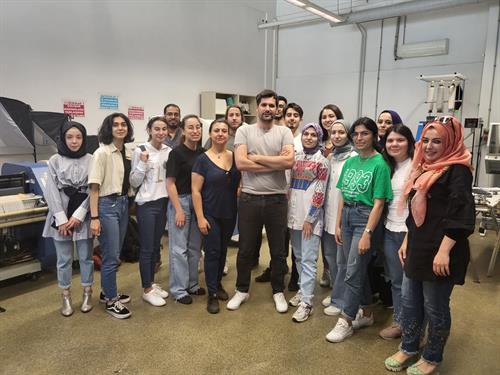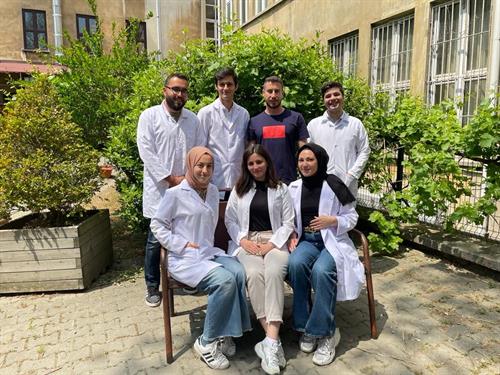The results of TÜBİTAK 2209-A projects under the consultancy of Assoc. Prof. Dr. Özgür Atalay and Assoc. Prof. Dr. Alper Gürarslan have been announced.
TUBITAK 2209-A University Students Research Projects Support Program 2021 2nd Term application results have been announced. 12 different projects submitted by our textile engineering students were entitled to be supported. Supported projects will be conducted under the consultancy of Assoc. Prof. Dr. Özgür Atalay and Assoc. Prof. Dr. Alper Gürarslan from our faculty.
We congratulate our students and wish them continued success.
Development of New Generation Mechanically Deformable Heaters with Knitting Technology Method
Student Team: Feyza KAR, Emre DOĞAN, Ayşe YILDIZ
Advisor: Assoc. Prof. Dr. Özgür Atalay
In this study, it is aimed to develop new generation heaters that are flexible, extensible, and compatible with mechanical deformations by using textile knitting technology, which provides production in a simple, fast, one-step process. An improved heater can be used in many areas, such as wearable electronics, wearable thermotherapy, soft robotics, medical, electronic textiles, military, and sports.
Soft Actuators with Integrated Resistive Sensor
Student Team: Ahmet Furkan YILANCI, Betül KAYGILI, Nezihe Cemrenur TEMİZ
Advisor: Assoc. Prof. Dr. Özgür Atalay
Within the scope of this project, resistive sensor integrated pneumatic actuators will be produced using knitting technology. The anisotropic properties and sensor integration that the actuators must have in order to make the necessary movements will be given directly to the structure during fabric production. With the successful completion of this project, it is aimed to create new technologies by contributing to Turkey's competitiveness in soft robotics and medicine.
Development of Capacitive Strain Sensors for Electronic Textile Applications
Student Team: Aylin KAYA, Eda GÜNDOĞAR, Emine MUTLU, Arzu TATAR
Advisor: Assoc. Prof. Dr. Özgür Atalay
In this project, it is aimed to produce single-layer interdigital capacitive strain sensors using knitting technology. Since the sensors are single-layer, thinner structures will be obtained compared to parallel-plate capacitors, and more compatible and flexible sensors will be developed. The study is expected to contribute to the advancement of existing technology in electronic textile application areas such as human body motion capture systems, capturing physiological signals (breathing), and posture tracking.
Development of Hybrid Structured Conductive Yarns for Electronic Textile Applications
Student Team: Damla KAYA, Deniz Can BAŞ, Yağmur YILDIRIM
Advisor: Assoc. Prof. Dr. Özgür Atalay
Within the scope of this project, studies will be carried out on the production of flexible conductive yarn to be used in textile structures in order to provide the flexibility, strength, and electrical conductivity properties expected from electronic textiles. In order to develop this hybrid yarn, different core (spandex in various thicknesses) and covering yarns (single and double ply, twisted and untwisted conductive yarns) and different production parameters (twist amount, number of covering yarns, core feeding rate, etc.) will be studied on the DirecTwist machine. Since it can be used in products in many fields such as health, fashion, military, sports, etc. where wearable electronics are used, it is aimed to meet the basic needs of a wide sector.
Optimization of Conductive Paths and EMG Electrodes Using Suture Techniques to Obtain Efficient Signals
Student: Gökay YILDIZ
Advisor: Assoc. Prof. Dr. Özgür Atalay
In this project, the effect of parameters such as stitch type, stitch pitch, stitch density, and distance between stitch lines on the measured EMG values will be investigated. It is aimed to make textile-based EMG sensors more efficient, which will be obtained by using various sewing techniques and geometries.
Production of Textile Based EMG Sensors with Knitting Technology
Student: Neslishah POLAT
Advisor: Assoc. Prof. Dr. Özgür Atalay
In this project, it is aimed to produce EMG sensors in a completely wearable and soft structure using knitting technology. It is aimed to produce an armband with integrated sensors from a comfortable and one-piece fabric, which includes sensors at the level of target muscle groups to monitor the movements of the hand and finger muscles, and where user/patient comfort is at the forefront with its flexible and human body-compatible structure.
Non-Woven Fabric Production from Poplar and Polylactic Acid Fibers and Wearable Sensor Applications
Student: Murat Mula
Advisor: Assoc. Prof. Dr. Alper Gürarslan
In this project, nonwoven fabric will be produced using the needling method using poplar fibers and bio-polymer polylactic acid fibers, which have the potential to be a serious alternative to traditional textile fibers. These fabrics will be coated with nanowires and converted into conductive ones. By creating a capacitive sensor from conductive fabrics, it is aimed to meet the needs of both textile-based electronics and sustainable new materials of the era.
Coating of Alginate Fiber with Silver Nanowires (Agnt) and Investigation of Antibacterial Properties
Student: Zeynep Sena Ozkan
Advisor: Assoc. Prof. Dr. Alper Gürarslan
Alginate fiber is used in wound dressings due to its cell regenerative and high absorption properties. In this study, it is aimed to develop an antibacterial alginate fiber containing AgNT to be used in the development of active wound dressing. Thus, it is aimed to shorten the wound healing time.
Increasing the strength of nonwoven surface fabric containing poplar fiber sprayed with Polylactic Acid (PLA)
Student: Rana Nur Tekbaş
Advisor: Assoc. Prof. Dr. Alper Gürarslan
Although non-renewable natural resources are decreasing day by day, the widespread use of petroleum-based fibers in the textile industry continues. In this study, it is aimed to improve the strength of nonwoven fabrics produced from sustainable poplar fibers with polylactic acid biopolymer.
First Time Investigation of Sound Insulation Properties of Non-Woven Fabric Containing Poplar Fiber
Student: Fehmi Cengiz
Advisor: Assoc. Prof. Dr. Alper Gürarslan
Most of the sound insulation materials harm the environment and cause many negative situations. As it can be understood from the UN Climate Report, if the necessary importance is not given to sustainable and environmentally friendly products in the coming years, human beings will face much worse situations. Therefore, as in many areas, it has become mandatory to use sustainable and environmentally friendly products in sound insulation. In this project proposal, it is aimed to create nonwoven fabrics from renewable materials and to examine their sound insulation properties.
Production of Wet Laying Surface and Characterization of the Formed Surface with Alginate Fiber of Different Lengths in the Development of Porous Alginate Fiber and Active Wound Dressing
Student: Magdalena Tihon
Advisor: Assoc. Prof. Dr. Alper Gürarslan
In this project, it is aimed to create a wound dressing that will contribute to the shortening of the wound healing time by using alginate fiber. In the study, a nonwoven surface will be obtained from alginate fibers by using the wet laying method. It is aimed to investigate the effect of the fiber lengths used in the dressing on the surface properties.
Investigation of the effect of the pool residence time of the alginate fibers obtained by the wet drawing method to be used as a wound dressing on the fiber formation
Student: Ahmet Faruk Demir
Advisor: Assoc. Prof. Dr. Alper Gürarslan
With this project, it is aimed that wound dressings obtained from alginate fibers with multifunctional properties will contribute to the healing process of active wounds. In the study, the effect of the residence time of the alginate fibers obtained by the wet laying process on the fiber formation will be examined.

